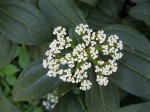 The dark green glossy leaves of this compact evergreen shrub are enough to recommend it but it also has large clusters of snow white flowers in early spring that brighten up any garden. The mounding habit and relatively small size, make it ideal for small gardens where it provides an especially handsome backdrop for later blooming annuals and perennials. In autumn female plants produces olive-shaped metallic turquoise-blue fruit about ¼” long if a male plant from a different clone is in the area. In orther words, don’t count on the fruit and consider them a blessing if your plant produces the. David virburnum is useful in borders or as a ground cover.
The dark green glossy leaves of this compact evergreen shrub are enough to recommend it but it also has large clusters of snow white flowers in early spring that brighten up any garden. The mounding habit and relatively small size, make it ideal for small gardens where it provides an especially handsome backdrop for later blooming annuals and perennials. In autumn female plants produces olive-shaped metallic turquoise-blue fruit about ¼” long if a male plant from a different clone is in the area. In orther words, don’t count on the fruit and consider them a blessing if your plant produces the. David virburnum is useful in borders or as a ground cover.
Type: Evergreen shrub.
Outstanding Feature: Handsome evergreen foliage.
Form: Dense, compact, mound.
Growth Rate: Moderate.
Bloom: Clusters of small white flowers in early spring.
Size: 3-5’ H x 3-5’ W.
Light: Full sun to part shade.
Soil: Moist, well drained.
Fertilizer: All purpose fertilizer in spring aftes growth begins.
Hardiness: Zones 7b-9.
Care: Low maintenance.
Pests and Diseases: None of importance.
Propagation: Seeds sown in autumn; semi-ripe tip shoots taken in summer.
Companion Plants: Azaleas, rhododendrons, redbud, dogwoods, Kwanzan cherry, daffodils, tulips.
Comments: Cross-pollination between two different clones is necessary for fruit set.

My David Viburnum is turning brown. I have trimmed the brown stems and leaves away from the bush but it continues to turn brown. Do you have any suggestions to keep the David Viburnum from turning brown and looking so bad.
Carol, The heat stress this summer has been severe here in mid North Carolina and I have the same problem with many shrubs. No amount of water makes up for the stress that endless days of over 90 degree weather can cause. Most shrubs and trees need at least 1″ of water/wee so give them a deep soaking if there is no rain. Clipping away the dead material makes them look better but be careful you are not clipping off the buds of next year’s flowers.
Karen
Carol,
What should I be using now to fertilize my Davidi Viburnum? Is Ironite or Hollytone appropriate? How about Miracle Gro?
I am also concerned about my Pieris Japonicas which don’t look too great right now………
Many thanks!
Stephanie
Stephanie,
Try a 10-10-10 in spring spread out to the drip line. I would recommend a soil test (call you area extension office) and that would tell you what elements are lacking so you could fine tune the fertilizer next year.
There are many things that could cause a Pieries japonic to look sad but they generally have a hard time with the winter but will recover. Send more information and your USDA zone and perhaps I can help.
Karen